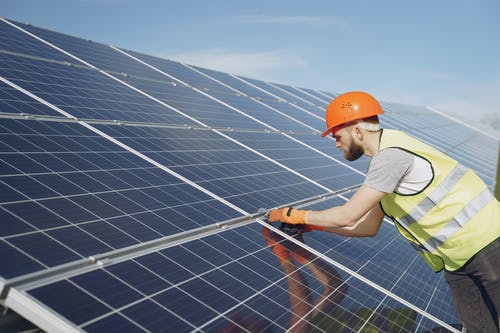Solar hot water systems collect solar thermal energy and utilize it to heat water for your home. Collectors, a storage tank, a heat exchanger, a controller system, and a backup heater are the key components of these systems. A solar thermal system’s panels, known as “collectors,” are often mounted on a rooftop.These collectors are different from photovoltaic solar panels in that they generate heat rather than electricity. Sunlight (or “solar radiation”) passes through a collector’s glass covering and reaches an absorber plate with a coating designed to capture solar energy and convert it to heat. This heat is transferred to a “transfer fluid” (antifreeze or potable water) contained within the plate via small pipes.
When the transfer fluid in your collectors heats up, it flows into a system of pipes known as a “heat exchanger,” which is placed inside your hot water storage tank. When these pipes are filled with heated transfer fluid, heat is transmitted from the pipes to your water, resulting in hot water ready for use in your home. Most solar hot water systems have a controller to guarantee that the water in the storage tank does not become too hot.When it is really cold outdoors and the transfer fluid is not sufficiently warmed, controller systems can prevent cold water from cycling through the system. Finally, every solar hot water system has a backup system. On days when it is too overcast for solar energy to generate enough heated water, your backup heater will kick in and generate hot water for your home using gas or electricity. Throughout the year, backup heaters will account for approximately 20% of your hot water consumption. Visit here to browse and get your solar-powered hot water installation gold coast.

The core components of every solar hot water system are the same, however, the overall design varies. You must decide whether to use a direct or indirect method, which affects how fluid is heated in the collectors. You must also select whether you want an active or passive solar hot water system, as this affects how fluid flows through your system. Integral collector-storage systems are made up of storage tanks that are heated by the sun. This hot water is then routed through plumbing systems for various purposes. They operate effectively in hot weather and for late-night hot water requirements. Thermosyphon systems are similar in that they use a collector on the roof to allow water to flow through a building’s plumbing system for hot water systems.

The main difference between direct and indirect solar hot water is the type of fluid used to capture heat in the system. In an indirect method, solar energy is captured and stored in a particular antifreeze fluid. To heat the water for use in your house, the antifreeze is poured into your hot water storage tank. In comparison, your water would be heated directly from the sun in a direct setup as opposed to first being gathered in a transfer fluid. While some homeowners in the country’s southernmost regions may benefit from direct solar hot water systems, the majority of locals will prefer to build an indirect system to reduce efficiency losses throughout the winter.





